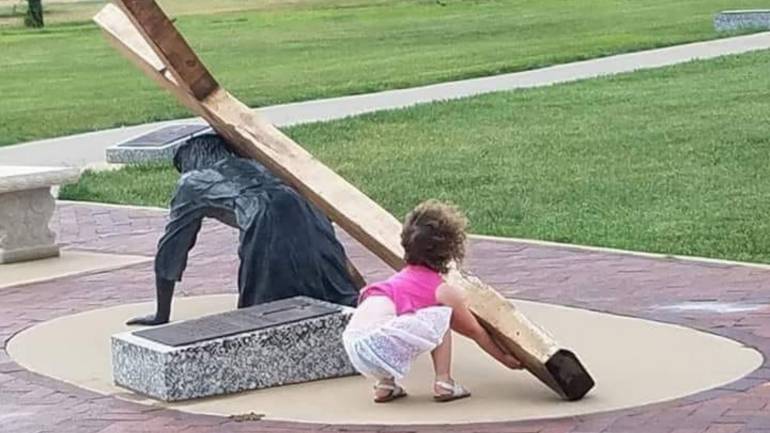Stations of the Life-Giving Cross of Christ: Historicity and Significance

The 'Stations', also called the 'Way of the Cross' in different contexts, is a highly recognizable and widely followed tradition within the Catholic faith. This devout devotion, historically centered on the Savior's suffering and demise, has evolved to incorporate a specific allusion to Christ's resurrection. Thus, the "Empty Tomb" encourages the believer to reflect inwardly on the fourteen steps that symbolize the momentous ascent of Christ to Calvary Hill.
Origins
This profound devotion originated from the pilgrimages the early Christians made to the various locales of significance associated with Christ’s Passion, Death, and Resurrection. The Franciscans further popularized this prayerful practice as they took over the custodianship of the historical sites in Jerusalem and the Holy Land in 1342. Gradually spreading to other parts of Western Europe, the numbers and names of stations varied periodically.
In the first half of the 17th century, Spanish Franciscan communities recorded the traditional set of fourteen, spreading it to Sardinia (then under Spanish domain) and then to Italy, where a Franciscan friar, Saint Leonard of Port Maurice (+ 1751), fervently embraced it. The famed Leonard tirelessly erected over 572 Via Crucis, including the famous one inside the Colosseum, in December 1750 at the behest of Pope Benedict XIV, who led the devotion on Good Friday. Pope Saint Paul VI revived the Colosseum Stations as a Papal Good Friday exercise that continued in the 20th century.
Steeped in history
Significantly, this devotional practice is also known as the “Via Dolorosa"—literally, the “Sorrowful Way." Geographically, the Via Dolorosa, alternately known as the Via Crucis (Way of the Cross), is a street in two parts within the Old City of Jerusalem. Considering the path Jesus traversed, carrying his cross, the winding route from the Antonia Fortress west to the Church of the Holy Sepulchre (a distance of about 600 meters) is a celebrated place of Christian pilgrimage. The current route, established in the 18th century (replacing all earlier versions), is today marked by nine ‘Stations’, with the remaining five stations within the Church of the Holy Sepulchre dating back to the 15th century.
Reality and Presumptions
The Via Dolorosa, in effect, commemorates 14 happenings traditionally marking Christ’s Cross journey from Pilate’s Judgement Seat, the Praetorium [Jn 18:28b]; The Roman soldiers engaged in grotesque tomfoolery by mocking, spitting upon, and thorn-crowning him as they led him through the streets of Jerusalem to Golgotha for crucifixion. Simon of Cyrene (Mt 27:26–35) and Veronica provided invaluable assistance to him.
In the passion narratives, there is no reference to the latter. Nevertheless, it is theorized that Jesus’ burial cloth, the ‘shroud’, was folded into a square frame and displayed above a church altar, with only an apparent imprint of his face visible. This imprint, now considered the 'True Image' [vera (Latin)+eikon/icon (Greek)] of Jesus, developed a legend about a woman named 'Veronica' daring to use her veil in public to wipe Jesus' blood-splattered face. Jesus repaid her soothing act of kindness by leaving his facial imprint on the veil.

Identifying with the Symbol of the Cross
The Stations reveal the extent to which God will go out of love for us. Those who identify with the Cross of Jesus and the Sorrowful Way leading to it will also identify with the unwillingness to destroy and crucify. The question is not who killed Jesus but what killed Jesus: a vicious cycle of hate and violence continues to make the Lord walk the via dolorosa in the men and women of our day, his re-crucifixion evident in his sisters and brothers.
In a world bereft of a sense of sin and shame, the scourging and physical pain that Jesus endured might appear as some sort of madness [cf. 1 Cor 1:23]. He successfully carried the burden of every human sin since Adam and Eve to the cross, making any contention seem minor in comparison to the pain it caused. And that success is what the Stations are meant to remind us of.
Indeed, as Lent progresses, our contemplation of this holiest of seasons reminds us of what a precious gift our salvation is, considering the ransom paid for it by Jesus: “But he was pierced for our transgressions, he was crushed for our iniquities; the punishment that brought us peace was upon him, and by his wounds, we are healed” (Isa 53:5). As we mull over the pain and humiliation he suffered for us, paying a price that we could never pay ourselves, we can’t help but praise and thank the Father for the superabundance of His love. Could we dedicate ourselves to a life of obedience to His Son with the help of the Spirit's power?
Way Traced by the Spirit
At the beginning of his mission, the Spirit led Jesus into the desert (cf. Lk 4:1); then, as a divine fire burning in his breast, the Spirit compelled him to trudge up Calvary (cf. Lk 12:49–50), the last stage of which was painfully hard. The evangelists linger, albeit with moderation, over the description of the journey of the Son of God and the Son of Man, designed to walk out of sheer love for the Father and His human creation.
Every step of Jesus is a step closer to the accomplishment of the Father’s will for our salvation: the hour of universal forgiveness (cf. Lk 23:34); the pierced Heart that opened an inextinguishable fountain of grace (cf. Jn 19:34); the immolation of the true Paschal Lamb, of whom not a bone was to be broken (cf. Jn 19:36); the gift of his Mother (cf. Jn 19:26–27); and the Spirit (cf. Mt 27:50)…. Every bit of suffering marking Jesus’ life journey is a seed of future joy for all humanity, every jeer, a premise of glory!
Similarly, every encounter with Jesus on the Via Dolorosa, with those familiar and those unfamiliar, enemies and the indifferent alike, is a chance for one final lesson, one last look, and one supreme offer of reconciliation and peace. And yes, all this, if contemplated with sincerity, will bring us on the same page with Jesus! Indeed! Lest the opportunity pass us by, let our soulful cry to the Lord be:
Pass me not, oh, gentle Saviour,
Hear my humble cry.
While on others thou art calling
Do not pass me by!
Radio Veritas Asia (RVA), a media platform of the Catholic Church, aims to share Christ. RVA started in 1969 as a continental Catholic radio station to serve Asian countries in their respective local language, thus earning the tag “the Voice of Asian Christianity.” Responding to the emerging context, RVA embraced media platforms to connect with the global Asian audience via its 21 language websites and various social media platforms.














